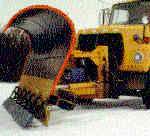U.S. Department of Transportation
Federal Highway Administration
1200 New Jersey Avenue, SE
Washington, DC 20590
202-366-4000
Focus
| Accelerating Infrastructure Innovations |
Publication Number: FHWA-SA-97-026
Date: August 1997
Maintenance departments planning for next winter's snowstorms might want to consider using snowplow scoops. This simple device, which attaches to plows that are mounted on the front of large trucks, can make plowing more efficient in those areas that receive lots of dry snow.
The snowplow scoop, which was developed under the Strategic Highway Research Program (SHRP), was designed to reduce the amount of energy needed to push a plow through dry snow. Conventional plows operate at almost a 90-degree angle to the surface of the road. The snowplow scoop, in contrast, attaches to the front of the plow blade at a roughly 45-degree angle to the pavement and rides slightly above the surface of the pavement. This angle makes it easier for the snow to flow smoothly from the pavement and across the plow. The result is a two-pronged attack on snow: the snowplow scoop picks up the top layer of the snow, and the plow cutting edge removes the snow left behind on the surface of the pavement.
The snowplow scoop has several benefits. Because it helps the snow flow smoothly onto the plow, the plow truck can operate at faster speeds, is easier to control, and is more fuel efficient than it would be with a standard plow. And because the snow flows up the plow surface in a sheet, rather than in chunks, there is less snow cloud around the plow, which means that visibility is improved for both the plow driver and nearby motorists.
The snowplow scoop has a very specific application, says Kynric Pell of the University of Wyoming, who developed the device. "The snowplow scoop was designed for nearly vertical plow blades and for use in dry snow," he says. "In addition, the truck should ideally be running at 45 mi/h [72 km/h] or so. It's meant for open highway in areas that receive large amounts of dry snow."
The experience of the Mono County (California) Public Works Department confirms the snowplow scoop's usefulness in the right conditions. The county, located high in the Sierra Nevada mountains, gets both dry snow and wet snow.
"Last winter, we had one storm with cold, dry snow, and the snowplow scoop performed as we had been told it would," says Ran Berlin of the county Public Works Department. "It picked the snow up better and got it out of the way of the truck better, improving visibility. But in wet snow it was a disadvantage, as snow got packed between the scoop and the plow." This prevents the plow's cutting edge from effectively clearing the snow that is not picked up by the snowplow scoop. The operator must then stop and clear out the snow.
Berlin also notes that the snowplow scoop was most effective on open highways where the plow truck could travel at speed. The scoop is also better suited to rural roads because it is made of a plastic that wears quickly when used on city streets with manholes, curbs, and other obstacles.
Mono County was one of 59 State highway agencies, local governments, tribal governments, and transportation technology transfer centers that offered to evaluate the snowplow scoop last winter. The Federal Highway Administration (FHWA) contracted with Riveer Co. of Saugtuck, Michigan, to provide snowplow scoops to those agencies.
The evaluation was initiated by former SHRP staff members John Hibbs and Shashikant Shah as part of an FHWA project to introduce local governments to SHRP products (see April 1997 Focus). Hibbs says the results of the evaluation are still out, as few agencies have sent in their comments, possibly due to the mild winter weather in much of the country.
FHWA also gave away 10 snowplow scoops at the Eastern Winter Road Maintenance Symposium and Equipment Expo last September. And State highway agencies in New Jersey, Ohio, and Texas began evaluating the device last fall as part of an FHWA test and evaluation project.
FHWA's Ray McCormick says, "I encourage users to send me any comments they may have. We're eager to know how well-or how badly-the snowplow scoop worked."
For more information or to comment on the snowplow scoop, contact McCormick at FHWA (phone: 202-366-4675; fax: 202-366-7909; email: ray.mccormick@fhwa.dot.gov).

The snowplow scoop, shown here mounted to the front of an experimental plow, can make plowing operations more efficient in areas that receive a lot of dry snow.